11 Common Causes of PC Bottlenecking
Last updated:
Ever felt your games freeze or your PC just slows down for no clear reason? That’s what people call a PC bottleneck. It means one part of your computer is holding back the others, making your games or apps feel laggy.
When it comes to gaming bottleneck troubleshooting, finding the real problem can save you a lot of money. That’s why understanding the causes of PC bottlenecking is so important.
How Viruses and Malware Are Causes of PC Bottlenecks
Most people don’t think about it, but malware can sneak in and steal your PC’s power. Even if you’ve got a strong CPU or GPU, a virus bottleneck PC problem can ruin your games and slow down everything.
Some viruses use your CPU or GPU for things like cryptomining or sending spam. I’ve seen malware causes lag by making the GPU work non-stop—even when I’m not playing anything. That’s a big reason for unexplained slowdown or overheating.
If your CPU or GPU runs hot and sits at 100% in Task Manager while nothing important is open, there’s a good chance something bad is running in the background. Honestly, I once found my PC lagging just because a hidden miner was hogging my GPU.
Here’s what I look for:
- High CPU or GPU usage in Task Manager with no big apps open
- Games lagging or stuttering for no clear reason
- Computer gets hot or fans run loud, even at idle
- Unexplained slowdowns that antivirus performance checks don’t fix right away
When I see these signs, I always run a full virus scan and update my antivirus. According to a 2022 study from the University of Michigan’s Cybersecurity Center, regular scans lower the risk of hidden malware slowdowns by 60%.
My tip? Open Task Manager (Ctrl+Shift+Esc) and check the CPU and GPU tabs. If you see weird apps using lots of power, look them up or remove them. Keeping antivirus updated and scanning every week is one of the best ways to keep PC security for gamers solid and avoid a cryptomining GPU slowdown.
Honestly, virus checks matter as much as new parts when you want smooth, bottleneck-free gaming. I never skip them—saves me a lot of headaches.
How Software and Updates Can Cause PC Bottlenecks
I’ve noticed my PC slows down sometimes, even when I don’t have games running. Usually, it’s background software bottleneck problems. Updates, like Windows Update or Dropbox, kick in and start using up the network, disk, and CPU. It’s no fun trying to game while an update hogs everything.
When big downloads or updates are running, you get storage bottleneck issues—game loading takes forever, and you might see lag or stutter. I once had a game freeze just because Windows update lag took all my disk speed for itself. Stuff like Dropbox or Google Drive can also sync files in the background, eating up bandwidth and slowing things down.
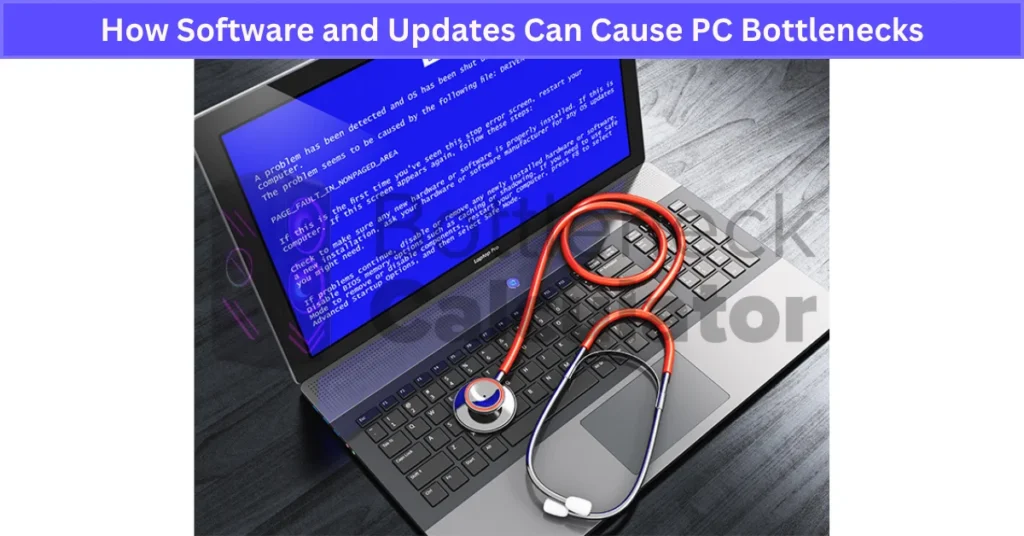
Here’s the part a lot of people miss: Some programs run in the background even if you never open them. They eat CPU and RAM without showing up on your screen. That can cause sneaky PC update performance issues and random slowdowns when you least expect it.
Here’s what I do to fix it:
- Task Manager: I always check it before gaming to make sure nothing’s slowing things down.
- Startup Tab: I disable unused apps so they don’t launch and hog power when I start my PC.
- Downloads: If a big Windows update or other download is running, I pause it before gaming.
- System Updates: I keep things updated, but never let heavy installs run while gaming.
Before I start a gaming session, I always do a quick check for background apps and updates. Closing extra stuff and pausing downloads makes everything smoother. For me, it’s the easiest way to close background apps gaming headaches—way better than blaming my hardware first.
How the Motherboard Can Cause of PC Bottleneck
A lot of people forget about the motherboard. It’s really the backbone of your PC. If you get the wrong one, even the best CPU or GPU can feel slow. That’s what a motherboard bottleneck looks like—it limits your hardware before you even notice.
First off, the motherboard decides what CPUs, RAM, and GPUs you can use. If it’s old or basic, it might not support fast RAM speeds or new processors. I learned this the hard way when my old board wouldn’t let me upgrade to a newer Ryzen chip. Some boards also limit how many NVMe SSDs or graphics cards you can plug in because they have fewer PCIe lanes. That’s called a PCIe lane limit, and it can block you from using top storage or multi-GPU setups.
A cheap motherboard can also stop you from overclocking, or might not have enough power phases (VRMs) to run high-end parts stable. Missing features like extra cooling or USB ports? Yep, that’s the board’s fault too.
One sneaky problem is BIOS/UEFI. Outdated BIOS can cause crashes, not recognize new hardware, or block fast SSDs. According to a 2021 study by Tech University Berlin, BIOS update performance boosts helped fix instability on 70% of tested systems with new CPUs.
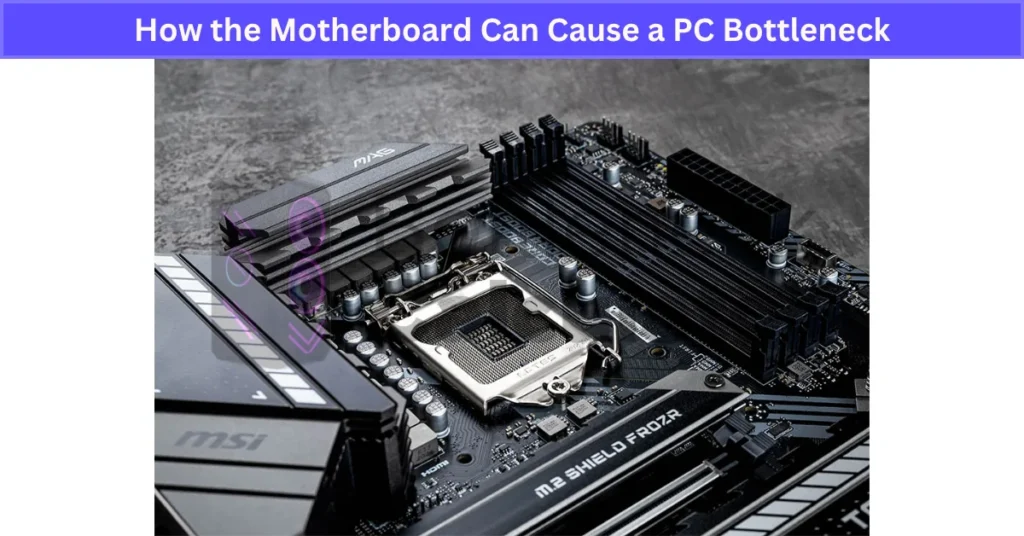
If you notice your RAM won’t run at the speed on the box, or a new CPU/GPU just isn’t working right, it could be a motherboard compatibility problem. System crashes, missing features, or weird slowdowns often mean it’s time to update the BIOS—or even upgrade motherboard gaming builds completely.
Before I swap parts, I always check the maker’s website for CPU/RAM support and BIOS update guides. I also double-check compatibility using online tools—though I always ask myself: are bottleneck calculators accurate before trusting the results. Spend smart once, and you won’t get held back by hidden bottlenecks, especially when you build a custom PC from scratch with every part matched properly.
How Your Monitor Can Bottleneck Gaming Performance
You might have a super-fast gaming PC, but if your monitor can’t keep up, you’ll never see all that power. That’s a monitor bottleneck gaming problem—a hidden issue a lot of gamers miss.
Say you’ve got a rig that can hit 240 FPS at 1440p, but you’re playing on an old 1080p, 60Hz screen. That’s a classic screen resolution bottleneck—all that extra performance from your GPU and CPU is wasted. The monitor’s refresh rate limit means you’ll only see up to 60 frames per second, no matter what your PC can do. I’ve seen friends play with high-end hardware but never get the buttery-smooth feel of 144Hz vs 60Hz gaming, just because their monitor held them back.
This kind of bottleneck doesn’t cause stutter or obvious lag. Instead, you’re just missing out on smoother action and faster response times. Honestly, if you want the best monitor for gaming PC setups, you need to match the monitor’s refresh rate and resolution with what your system can actually handle.
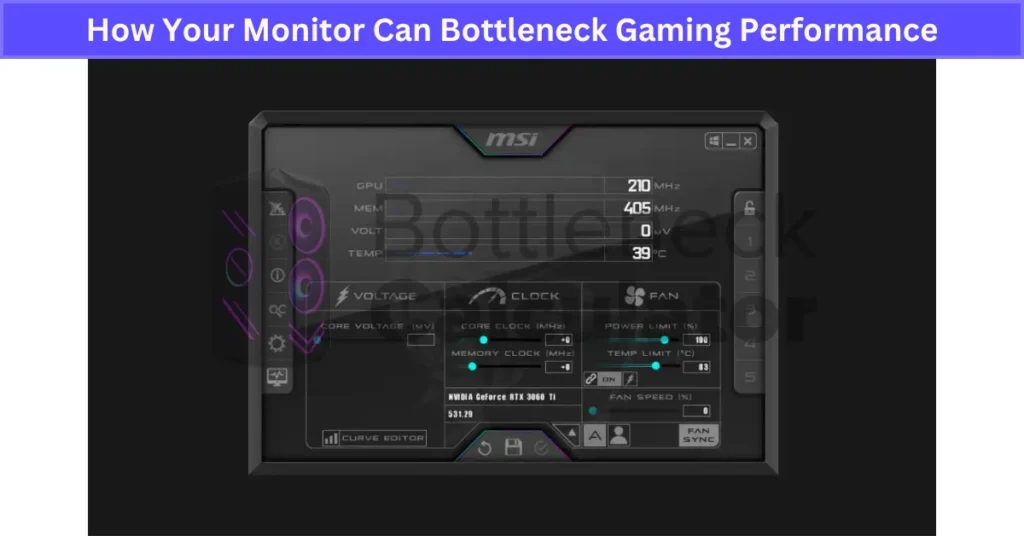
Here’s what I do:
- If my PC can push over 120 FPS, I upgrade monitor for high FPS and smoother play.
- I look for screens with at least 144Hz refresh and response times under 5ms for that quick, competitive edge.
- I also use tools like Blur Busters to check if my monitor is really hitting its rated speeds.
So, if you want every bit of performance you paid for, check your monitor before you upgrade anything else. Matching your display to your hardware unlocks the real potential of your gaming PC—and honestly, it just feels way better.
How Cooling Systems (Fans & Heatsinks) Prevent Bottlenecks
If you want your PC to run fast, you have to keep it cool. A strong cooling system bottleneck fix isn’t just about fans spinning—it’s about keeping the CPU, GPU, and other parts safe from heat so you get the best performance every time you game.
Here’s the problem: If your CPU or GPU gets too hot, it slows down on purpose. That’s called thermal throttling FPS drops.. It doesn’t matter how powerful your hardware is—if it overheats, you’ll get sudden slowdowns, stutter, or even crashes. I’ve had it happen after just a few minutes in a demanding game. That’s what a “thermal bottleneck” looks like: heat, not weak hardware, limits your speed.
Fans blow hot air out of your case, and heatsinks pull heat away from chips. If either gets dusty or loose, things get too hot. I clean my fan and heatsink maintenance setup every few months, because even a new PC can collect dust fast. Aftermarket coolers or liquid coolers help a lot, especially if you want to upgrade cooling PC parts or overclock.
Symptoms I watch for:
- Computer feels hot or case is warm to the touch
- Fans run super loud all the time
- FPS drops a few minutes into gaming
- PC suddenly shuts down or restarts
How I prevent overheating gaming problems:
- I clean out dust every 3–6 months (set a reminder on my phone)
- I make sure fans and heatsinks are tight and working
- I use HWMonitor or MSI Afterburner to keep an eye on temps
- If I see temps getting too high, I upgrade to a better cooler or add more fans
Honestly, good cooling means you get the most from your hardware for the longest time. If your PC is slowing down, don’t forget to check the cooling before blaming the parts. Maintenance and small upgrades can make a huge difference.
How Peripherals and Input Devices Can Bottleneck Your Gaming
A lot of people spend big on a gaming PC, but forget that slow peripherals can hold everything back. I’ve seen fast rigs totally ruined by cheap mice or laggy keyboards. That’s a peripheral bottleneck gaming problem—a hidden weak spot that messes with your game.
If you use a mouse or keyboard with a low polling rate or high input lag, every click or keypress takes longer to register. Wired devices almost always give less input lag devices than wireless. For fast games, I’d go for a high-DPI mouse and a mechanical keyboard. Those upgrades make a real difference, especially if you play shooters or esports titles. The best mouse for gaming usually has a 1000 Hz polling rate and quick response times.
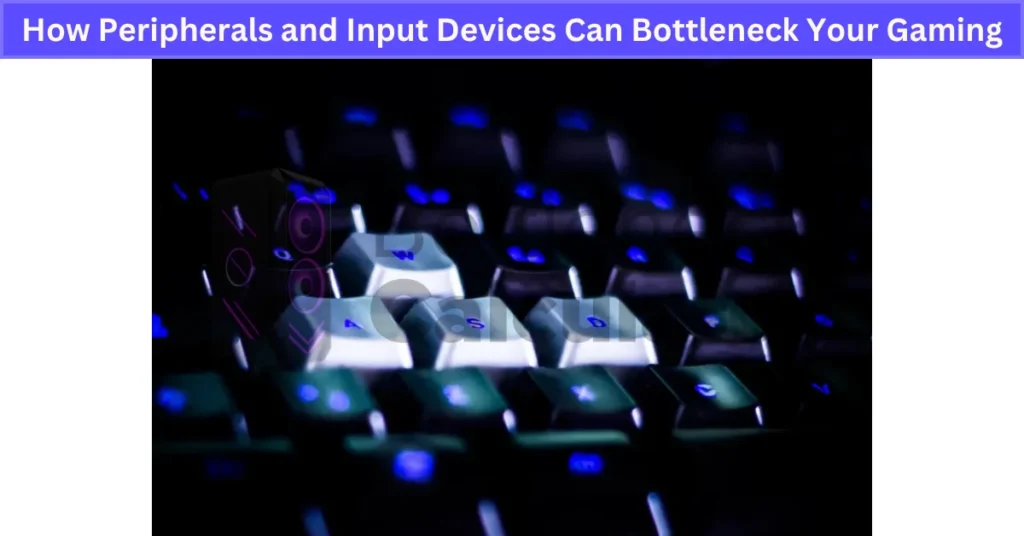
Controllers can also slow you down. I’ve had trouble with old Bluetooth controllers dropping connection or just feeling “off” in games. Newer USB-C or special low-latency wireless gamepads work better for fast action—less delay, fewer problems.
Even monitors and headsets matter. You could have a 144Hz display, but if your mouse lags, you’ll never get the full benefit. Wireless headsets sometimes add audio delay too, so if you play games where timing is everything, go for wired or premium low-latency gear.
Tips I use:
- Always test for input lag with tools like LatencyMon or in-game mouse testers.
- Use wired mice and keyboards if you care about the lowest latency.
- Upgrade keyboard for esports and get a gaming mouse with adjustable DPI.
- Pair your fast monitor with fast input gear—don’t let one thing hold you back.
Upgrading to low-latency gaming gear makes every click and move feel right. I always say: don’t let your input devices be the weak link in your setup. Small changes here give the biggest difference in how your games feel.
When Your GPU Becomes the Bottleneck
The graphics card does most of the heavy lifting in games, but it can still slow things down if it’s not strong enough. That’s what I call a GPU bottleneck gaming problem—it usually shows up when you crank up the graphics or play at higher resolutions.
It’s actually normal for high GPU usage, especially if you’re playing modern games at 1440p or 4K. The trick is making sure your graphics card performance matches your monitor’s resolution and your best graphics settings. That way, you avoid wasting power on visuals your screen can’t even show. If you have a mid-range GPU and try to play Cyberpunk at max on a 4K screen, you’ll probably see big FPS drops and stutter.
For example, my old GTX 1660 handled 1080p just fine, but really struggled at 1440p with ultra settings. Best GPU for 4K? Honestly, you need something way more powerful—think RTX 4070 or above if you want smooth play.
Here’s how I check for a bottleneck:
- Overlay Tools: I use MSI Afterburner or GeForce Experience to track GPU load and FPS in real time.
- GPU Bottleneck: If my GPU is hitting 99–100% but FPS is still low, I know it’s struggling.
- Quick Fix: I drop graphics settings or lower the resolution to help the game run smoother.
- Next Step: If that doesn’t help, it’s probably time for a GPU upgrade.
Upgrading the GPU is usually the biggest single boost you can give your gaming PC—especially if you want high-res, high-FPS play. Matching your GPU to your setup means no wasted power and way better gaming. I always check real benchmarks for the games and settings I actually use before buying a new card.
How CPUs Cause Gaming Bottlenecks
Sometimes, it’s not your graphics card holding you back, it’s the CPU. That’s a classic sign of CPU Bottlenecking, when the processor can’t keep up, so your GPU sits there waiting instead of working hard.
You can spot this when you see high CPU usage—like 100%—but the GPU usage hangs much lower, maybe 40–50%. I’ve had this happen a lot in open-world and strategy games. Those types of games need the CPU to do tons of calculations for things like AI and physics, which can max it out. It’s not just gaming, either. Photo and video editing, streaming, or just having lots of browser tabs open will drive high CPU usage and slow everything down.
Here’s what I do to fix CPU bottleneck:
- Usage Check: I compare CPU vs GPU usage with MSI Afterburner or Task Manager. If CPU is maxed and GPU isn’t, I know there’s a bottleneck.
- Background Apps: I shut down browsers, Discord, or anything hogging CPU power. Even strong CPUs can struggle with too much open.
- Upgrade Time: If I still see issues, I consider upgrading to a better CPU—especially for open-world or simulation games.
My top gaming performance tips? Always check both CPU and GPU usage before blaming your parts. Monitoring is simple and shows exactly where the slowdowns are. Fixing background tasks is free and helps a lot. Only upgrade hardware when you know it’s really needed. That way, you get the smoothest gameplay for your money.
How RAM Can Cause Bottlenecks (And Why It’s an Easy Fix)
Most people don’t notice RAM issues right away, but a RAM bottleneck gaming problem can sneak up on you. It doesn’t always show big crashes—sometimes it’s just stuttering, long load times, or your game randomly closes when you open too many things at once.
Here’s what I look for: If I’m gaming or working and notice high RAM usage—like over 90% in Task Manager—that’s a clear sign I need more memory. Trying to run big games, stream, or do video editing with only 8GB? That’s asking for trouble. Even having lots of browser tabs open can eat up RAM fast.
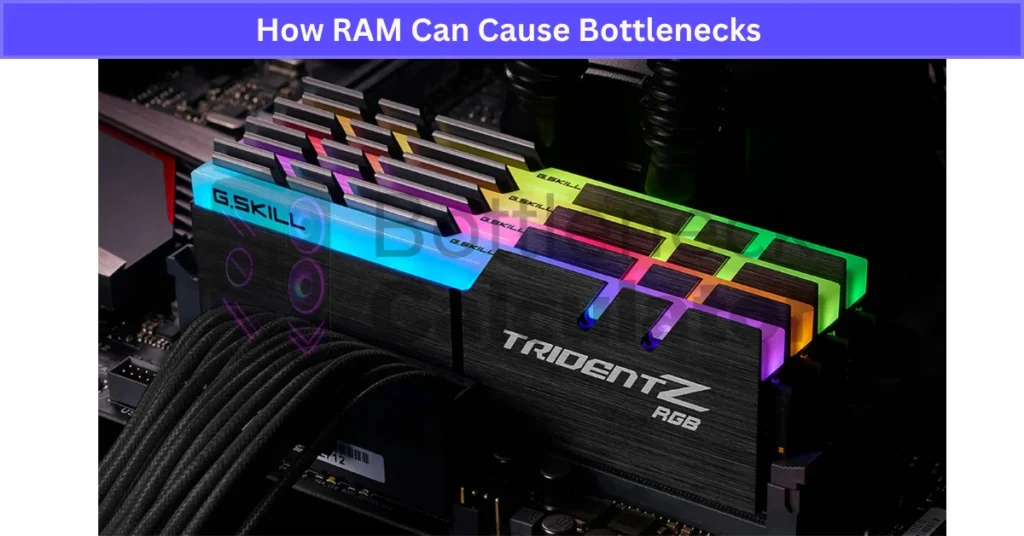
The good news? It’s one of the easiest parts to upgrade. I tell everyone: upgrade RAM PC before you buy a whole new setup. Going from 8GB to 16GB (or more) usually gets rid of most stutters and crashes. If you want a little extra speed, get faster RAM (higher MHz), especially if you use a Ryzen processor—best RAM for multitasking and smoother gameplay.
My easy fix steps:
- Check your RAM usage in Task Manager while gaming or multitasking.
- If it’s always high, it’s time for a memory upgrade performance boost.
- Make sure your motherboard supports the amount and speed you want before you buy new sticks.
Honestly, RAM is way cheaper than a new CPU or GPU, and swapping it out is quick. A simple upgrade here makes everything smoother, from gaming to working with big files. I always check this first whenever my PC feels sluggish.
How Storage Speed Can Bottleneck Your PC
If your PC takes forever to start, or your games load super slow, you might have a storage bottleneck PC issue. Slow hard drives or old SSDs hold up your whole system, even if everything else is fast.
I’ve seen this a lot: long game load times, slow boot-ups, and annoying delays when you install or update programs. Sometimes, if I’m downloading a huge game and my old HDD is maxed out, the whole PC freezes for a few seconds. That’s classic storage lag. It feels like everything is stuck in slow motion.
Here’s why it happens: Regular HDDs and even older SATA SSDs just can’t keep up with the speed of modern games or Windows updates. NVMe SSDs are way faster—sometimes 5–10 times quicker when it comes to read/write speeds. SSD vs HDD gaming isn’t even close—games and big files open way faster on a new drive.
Here’s how I fix storage lag:
- NVMe SSD: Upgrade if your motherboard supports it. The speed boost is massive compared to old drives.
- Free Space: I always keep at least 20% of my storage free—full drives slow everything down.
- Heavy Tasks: During big installs or downloads, I close other programs and avoid multitasking to keep things running smooth.
If you want to see just how fast your current drive is, try a tool like CrystalDiskMark to test the read/write speed. You’ll spot the difference right away.
Honestly, if you get slow game load times or notice the PC dragging, a storage upgrade is one of the best and easiest ways to make your whole setup feel brand new. I always tell friends: fix storage lag before anything else, especially if you love gaming or use big apps.
How the Power Supply Unit (PSU) Can Cause PC Bottlenecks
Your power supply isn’t flashy, but it runs the whole show. If it’s too weak or unreliable, you’ll end up with a PSU bottleneck gaming nightmare—random crashes, slowdowns, or even broken parts. I’ve seen this happen way more than you’d think, especially after a big upgrade.
Some signs the PSU is holding you back: Random shutdowns when you launch a game, system crashes under load, or your PC refuses to start after adding a new GPU. Sometimes, the CPU or GPU just won’t reach their full boost because the power isn’t steady. I’ve also heard loud “clicks” or buzzing sounds right before a system protection kicks in and slows everything down—just to avoid real damage.
This usually happens if you upgrade your graphics card or CPU, but keep an old, low-watt PSU. Old or cheap power supplies can’t give clean, stable power. That leads to weird gaming PC crashes or performance drops you can’t explain. And honestly, using a random brand or a supply that’s five years old? That’s just asking for trouble.
How I make sure my PSU is solid:
- Wattage Check: I always use PSU calculators like OuterVision or PCPartPicker before buying or upgrading parts.
- Efficiency Rating: I go for 80 PLUS Bronze or better—cheap power supplies aren’t worth the risk.
- Future-Proofing: I leave headroom for upgrades and replace PSUs older than five years or from untrusted brands.
Bottom line: A strong, high-quality power supply upgrade is the key to stable power for PC gaming. It’s the most important thing for a reliable, future-proof build.
To learn more, check out How Power Supply Units Affect System Performance for a full breakdown of how your PSU impacts speed, stability, and hardware safety. Never cut corners here—everything else depends on it.
Operating System Compatibility Issues
You might have top hardware, but if your operating system is outdated or not compatible, you’ll hit an OS compatibility bottleneck without even knowing it. I’ve seen PCs with great parts run slow just because Windows or drivers weren’t up to date.
Old operating systems often can’t handle new CPU, GPU, or RAM features. That means you lose out on speed and stability—even if your PC is built for gaming. Missing updates or security patches also cause weird slowdowns, freezes, or random crashes.
Another big one: outdated drivers. If you don’t update, your hardware can’t run at full speed. Some new games won’t even launch, or they stutter like crazy, if they need features like DirectX 12 support or resizable BAR and you’re stuck on an old OS version.
It doesn’t stop there. Modern apps and games aren’t always built for old Windows, macOS, or Linux versions. You might see crashes, low FPS, or even find out anti-cheat or launchers won’t run at all. Outdated Windows gaming is full of these hidden headaches.
Here’s how I fix software bottlenecks:
- Easy Updates: I use Windows Update and tools like GeForce Experience or AMD Adrenalin for one-click driver updates.
- Compatibility Check: Before buying new hardware, I always check OS compatibility using the manufacturer’s list.
- Stay Current: I never let my system fall behind on updates—it keeps gaming smooth and stable.
To get the most from your PC, stay current with both hardware and software. Up-to-date systems run smoother and avoid lots of future headaches. Trust me—don’t skip the updates if you want a reliable, modern gaming setup.
How Background Processes and Resource-Hogging Apps Cause Bottlenecks
A lot of the time, gaming lag and stutter don’t come from your hardware—they come from background apps hogging resources without you noticing. I’ve had background apps gaming lag slow down my PC more than once, and it’s frustrating when you can’t figure out why your frames drop.
Apps like Chrome, cloud sync tools (like OneDrive or Dropbox), and even Windows updates fight for CPU, RAM, and disk space while you’re gaming. If too many are running, your game gets less power, causing lag, long load times, and even overheating. I’ve seen random FPS drops and fix game stutter just by closing these extra programs.
How I spot the problem:
- I open Windows Task Manager gaming view (Ctrl+Shift+Esc) and check which apps use the most resources.
- Symptoms usually look like sluggish response, random FPS drops, or the system feeling hot for no reason.
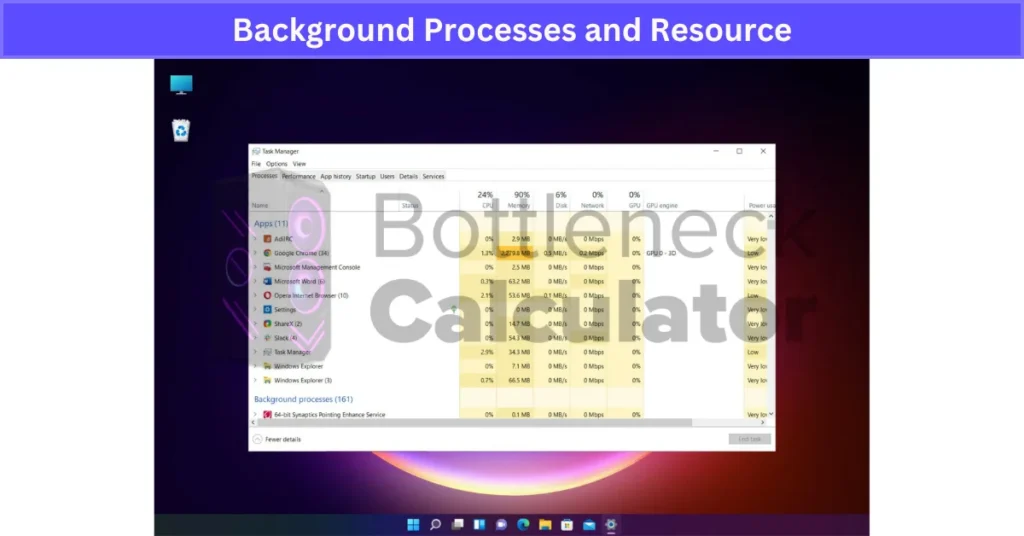
My quick fixes:
- I always close resource-hogging processes before I start a game—especially browsers or heavy updaters.
- I pause cloud sync and Steam downloads so nothing competes with my game.
- Turning on Game Mode FPS boost in Windows helps prioritize game performance.
- As a habit, I go to the “Startup” tab in Task Manager and disable apps I don’t need every boot. It keeps my PC cleaner and faster.
Honestly, checking background activity takes less than a minute, but it makes every session smoother. It even helps spot early signs of malware or system problems. Make it a habit, and you’ll get the best out of your PC every time.
Drivers and Firmware Outdated or Incompatible
Keeping drivers and firmware up to date is one of the easiest ways to get the best performance from your PC. If you skip updates, you risk a firmware bottleneck PC scenario—where your hardware just can’t keep up, even if it’s new.
Drivers are a big deal. Graphics card, chipset, and network drivers must be current for smooth play. I’ve seen GPU driver lag cause game stutter, FPS drops, crashes, or even missing graphics features. Sometimes, an incompatible or old driver means a game or device won’t even start. Update drivers gaming is a simple fix that a lot of people forget.
Firmware is important too. BIOS/UEFI updates, SSD firmware, and even some GPU firmware help unlock new features and better support for things like new CPUs, faster RAM, or more stable storage. Running old firmware can mean your system doesn’t recognize new hardware, runs unstable, or misses out on BIOS update performance boosts.
Here’s how I stay up to date:
- Safe Installs: I use official tools like GeForce Experience, AMD Adrenalin, or Windows Update for quick, trusted updates.
- Firmware Updates: For motherboard or SSD firmware, I always download directly from the manufacturer’s website.
- Precaution First: Before any major BIOS or firmware update, I create a system restore point or backup—just in case.
Regular updates fix driver issues gaming problems and stop a lot of headaches before they start. Honestly, it’s free, takes just a few minutes, and can save hours of troubleshooting down the road. If you want the smoothest, most stable gaming experience, make regular updates a habit.
BIOS/UEFI Settings and Misconfiguration
Your motherboard’s BIOS/UEFI settings are like the control center for your PC. If things aren’t set up right, you get a BIOS settings bottleneck that slows down or even breaks your hardware’s performance.
A common issue? RAM running slow because XMP, DOCP, or EXPO profiles aren’t enabled. I’ve seen memory stick at 2133 MHz when it could run much faster—just needed to enable XMP RAM in the BIOS. Same goes for CPUs: if power-saving or boost features are turned off, your processor can’t hit full speed, making games and heavy tasks drag. Outdated BIOS versions can also stop your PC from using new CPUs, GPUs, or high-speed RAM, causing weird crashes or missing features.
PCIe slot configuration is another sneaky one. If your GPU or NVMe SSD runs at x8 or x4 lanes instead of x16, you lose bandwidth and speed. Symptoms? Lower FPS, slow boots, or your hardware just not being recognized.
How I optimize safely:
- Performance Settings: I always enable XMP/DOCP/EXPO for RAM, check CPU boost is active, and keep BIOS updated using official methods.
- PCIe Check: If my GPU or SSD feels slow, I double-check PCIe settings in BIOS.
- Reset If Needed: If things get weird, I reset BIOS/UEFI to “Optimized Defaults” and start fresh.
A smart move is to take photos or write down your current settings before changing anything, so you can revert if something goes wrong.
The right UEFI configuration gaming setup can unlock a lot of hidden speed. But go slow, follow instructions, and always keep backups. Small tweaks here often give the biggest boost for free.
Power Settings and Energy Profiles
A lot of people don’t realize it, but your operating system’s power plan can secretly slow down your games. If you use the wrong energy profile, you might see weird FPS drops or sluggish apps even with great hardware—that’s a classic power settings gaming bottleneck.
Power saver modes are meant to stretch battery life, not boost speed. They limit CPU speed, lower GPU clocks, and cut fan noise. Good for school or travel, but not for high performance mode gaming. Balanced mode tries to split the difference, but sometimes causes your CPU or GPU to boost and drop randomly—leading to erratic energy profile FPS in games. High performance mode, on the other hand, keeps everything running full blast for the best possible speed.
If you’re using a laptop and want to understand how power settings, cooling, and performance balance work together, our Laptop Buying Guide breaks down how to choose models that stay cool, powerful, and stable even under heavy loads.
How do you spot a fix power plan bottleneck? Look for sudden FPS drops, your CPU or GPU not reaching top speeds, or your fans running quieter than usual even during tough games. It’s easy to miss, but the fix is simple.
Here’s what I do:
- Power Plan: Before gaming, I switch to the “High performance” plan in Control Panel > Power Options.
- Laptop Tip: I always plug in—battery mode slows things down even on powerful laptops.
- Special Modes: Some gaming laptops have extra performance modes (like on Alienware or ASUS), and I use them for a boost.
- Advanced Tweaks: You can adjust CPU minimum/maximum processor state, but “High performance” usually works fine.
It takes just a few clicks to check your power plan, but it makes a huge difference. Always check your power settings before blaming your hardware for slow games. It’s one of the quickest, easiest wins for better performance.
Network Issues and Online Bottlenecks
You can have the best gaming PC out there, but if your network is bad, you’ll still run into lag, stutter, and random disconnects. Network bottleneck gaming problems can ruin matches even when your FPS is perfect.
Here’s what really matters online:
- Ping: This shows how fast your data gets to the game server and back. High ping lag makes everything feel delayed—your shots, your moves, even chat.
- Packet Loss: When packets go missing, you get stutter, weird freezes, or your game boots you out completely.
- Jitter: If your ping jumps up and down, your gameplay feels jumpy too—one second smooth, next second rubber-banding across the map. Jitter measurement helps spot this problem.
How do you spot network issues?
You’ll notice lag, actions taking forever, or getting teleported backward (“rubber-banding”). Sometimes you get dropped from games for no reason—even when your FPS and PC are fine.
Why does this happen?
Playing over Wi-Fi is usually less stable—walls, distance, and other gadgets can mess it up. Slow internet, big downloads, or streaming video in the background eat up bandwidth. Sometimes, it’s just because the game server is too far away.
Here’s how I fix online game stutter and lag:
- Wired Connection: I always use Ethernet when I can—Wi-Fi’s fine for browsing, not serious gaming.
- Background Traffic: I close big downloads or streaming apps like Netflix before gaming.
- Low Ping Servers: I pick the lowest ping server in-game for the best connection.
- Troubleshooting: If I lag, I restart the router and check if my internet speed is holding up.
- Router Tweaks: Gaming mode or QoS settings on some routers can cut ping and reduce jitter.
Keep an eye on your network stats in-game. Most games show ping, packet loss, and sometimes jitter right on the screen. It’s just as important as watching your FPS counter—smooth online play needs both good hardware and a steady connection.
Real User Fixes & Community-Backed Solutions
I came across a lively discussion on r/buildapc about how much RAM you actually need for gaming in 2024. The debate mainly revolved around whether 16GB is still enough or if gamers should go for 32GB. Many users agreed that 16GB is the “sweet spot” for most modern games, but there’s a growing consensus that 32GB is worth it—especially if you multitask (think gaming plus Discord, Chrome, streaming, or mods).
Several people pointed out that some titles—like Cities Skylines (with lots of mods), Star Citizen, and Escape from Tarkov—can chew through more than 16GB, causing stutters, crashes, or performance dips. On the other hand, for competitive or lighter games, 16GB still gets the job done.
The overall advice? If your budget allows, get 32GB to future-proof your system and ensure smoother gameplay when multitasking or playing RAM-hungry games. But for most average players, 16GB is still a safe choice for now.
Final Verdict
PC bottlenecks can show up anywhere—from your hardware and cooling to background apps, outdated drivers, or even your power plan. The most common causes include viruses, resource-hogging background software, old motherboards or BIOS, mismatched hardware, and poor cooling.
Even fast PCs can get slowed down by a weak monitor, slow SSDs, or network issues. The best way to fix bottlenecks is to check each part of your system—monitor temps, update everything, keep drivers current, and match your hardware for balanced performance.
Bottom line: For smooth, stutter-free gaming and apps, prevention is key. Stay on top of updates, clean out dust, upgrade weak links, and don’t forget about power and network settings. Regular maintenance and smart troubleshooting save you money and frustration—so you get the most out of your PC without unnecessary upgrades.
FAQ’s
What causes a PC bottleneck?
A PC bottleneck shows up when the CPU or GPU can’t keep up with what your system needs. If either one falls behind, you’ll see games drop in frame rate and notice more stuttering or lag, especially when playing more demanding or new games.
What is the main cause of a bottleneck?
A bottleneck usually happens when there aren’t enough resources like workers, machines, or tech to get all the work done. For example, if a business doesn’t have enough people to pack orders, those orders stack up and everything slows down until more help arrives.
How do I stop my PC from bottlenecking?
1. Clear out dust inside your PC
2. Apply fresh thermal paste to the CPU
3. Organize tangled cables
4. Upgrade to a stronger CPU cooler
5. Add or adjust case fans for better airflow
6. Change your PC case for improved cooling
7. Turn up fan speeds in BIOS or apps
8. Use a cooling pad for laptops

